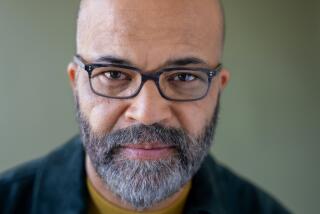T.C. Boyle discusses ‘The Women’
“We are both architects in a way. We both deal with structure, we are both artists, and we are both egomaniacs. I have worn a cape. There is where we end.” With this, T.C. Boyle cocked one of his circumflex eyebrows and addressed a glass of Moscato that stood before him on the marble countertop of Gottino, a wine bar in lower Manhattan.
The 60-year-old novelist responsible for so many of the greatest hits of contemporary American fiction -- “World’s End,” “The Road to Wellville,” “Drop City” -- was talking about his latest novel, “The Women,” and its larger-than-life, cape-wearing, egomaniacal subject: Frank Lloyd Wright. Boyle went on to identify a key difference between himself and the creator of Fallingwater and the Guggenheim Museum: “I need absolute tranquillity to create. He needed complete turmoil.”
And so “The Women” is an account of the earthly chaos that somehow managed to feed Wright’s transcendent designs, starting around the time of the 1925 fire (shoddy wiring) that consumed his Wisconsin studio and estate, Taliesin, and working backward toward a first fire in 1914 (arson and murder) via the architect’s incendiary relationships with his various wives and paramours.
Along the way, Boyle gives us glimpses of the architectural superhero at his most compromised: stiffing grocery clerks, putting apprentices to work peeling potatoes, enduring an epic bout of dysentery in Tokyo while developing the Imperial Hotel and being felled by seasickness on various ocean crossings. The subject of seaworthiness prompted a typically corrosive, Twainian assessment of human nature. “There is nothing more beautiful,” Boyle declared, “than seeing someone you really like -- your best friend, even -- puke over the side of the boat. It makes you feel great.”
What emerges in “The Women” is an entirely devourable, often cartoony portrait of one of modernity’s greatest artists as -- in the words of of his second wife Miriam, a morphine addict prone to flights of delusion and jealous rage -- a “venal dirty insufferable little coward.”
Boyle made a series of pilgrimages in the course of writing “The Women” -- which was completed, he noted, before the publication of last year’s bestselling Wright novel “Loving Frank” by Nancy Horan. He visited the architect’s famed Prairie Houses in Oak Park, Ill., and Taliesin, lining up with the hordes that pass through these shrine-like masterworks every day.
But Boyle didn’t need to travel far to get inside Wright’s imagination: He and his wife, Karen, live in the oldest Wright dwelling in California, the redwood-clad George C. Stewart House in Montecito, which is celebrating its centenary this year and pops up in a sly footnote in the book. Lately, Boyle has been in the midst of restorations on the structure -- which he bought in 1993 and where he has created some of his best-known work -- and can talk linseed oil, creosote and primer like the most possessed weekend do-it-yourselfer.
Don’t mistake him, though, for a preservationist savior: “I just keep it from falling down. If the cantilevers ever go, I’ll have to get my own federal bailout to fix it.”
The engineering may be sound for now, but the Tea Fire, which raged through the Santa Barbara area last November, came dangerously close to the Stewart House’s ancient timbers, threatening a Taliesin-esque fate. “I was on the roof, hose in hand,” Boyle wrote on his blog, “while it played monstrously over the hills, as if my laughable will and the puny stream of the hose would do any good.”
Conflagrations, end times and Armageddons are never far from Boyle’s mind. His conversation is dusted with references to overpopulation and the feasibility of hydrogen-powered cars, and his next novel, “When the Killing Is Done,” will take on the subject of eradication biology -- the idea that the genocide of nonnative fauna can wrestle ecosystems back into their natural alignments. (The book is set on the Channel Islands.)
And when Boyle gets a good head of steam going, he can rail about the apocalyptic decline of the print business as well as any commenter on Poynter: “What you and I are doing is so antiquated it’s like being a blacksmith watching the Model T rolling by.”
With Wrightlike vigor, Boyle rattled off his own multi-pronged plan to get America out of its economic and environmental tailspin, before catching himself up. “But I’m not running for office,” he said, as one of Gottino’s patrons did a double take, recognizing his Bill Haley forelock, Van Dyke beard, red Chuck Taylors and overall Ichabod Crane mien. “I would prefer to seize power. But it would distract me too much from writing books.”
Rozzo is a writer and critic living in Brooklyn, N.Y.
More to Read
The biggest entertainment stories
Get our big stories about Hollywood, film, television, music, arts, culture and more right in your inbox as soon as they publish.
You may occasionally receive promotional content from the Los Angeles Times.






